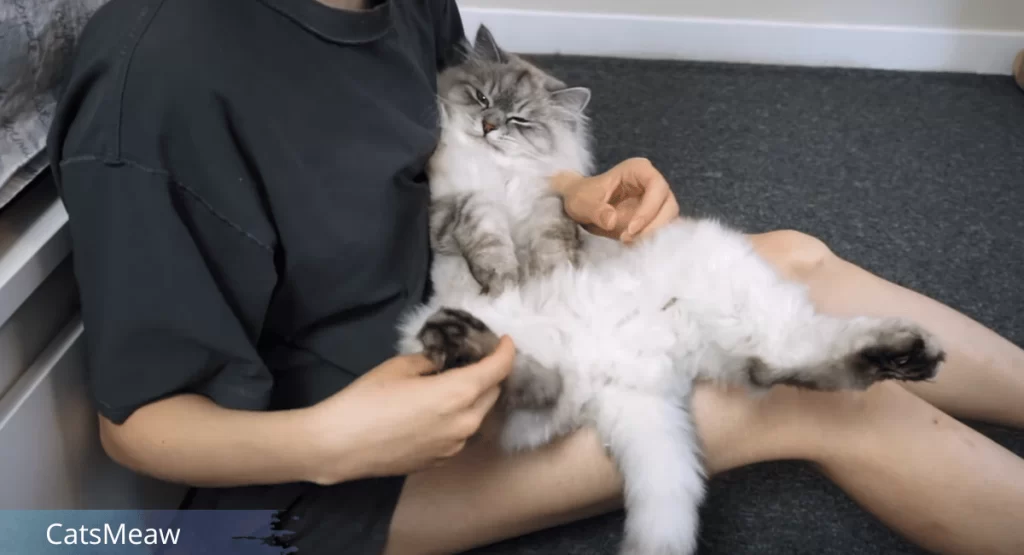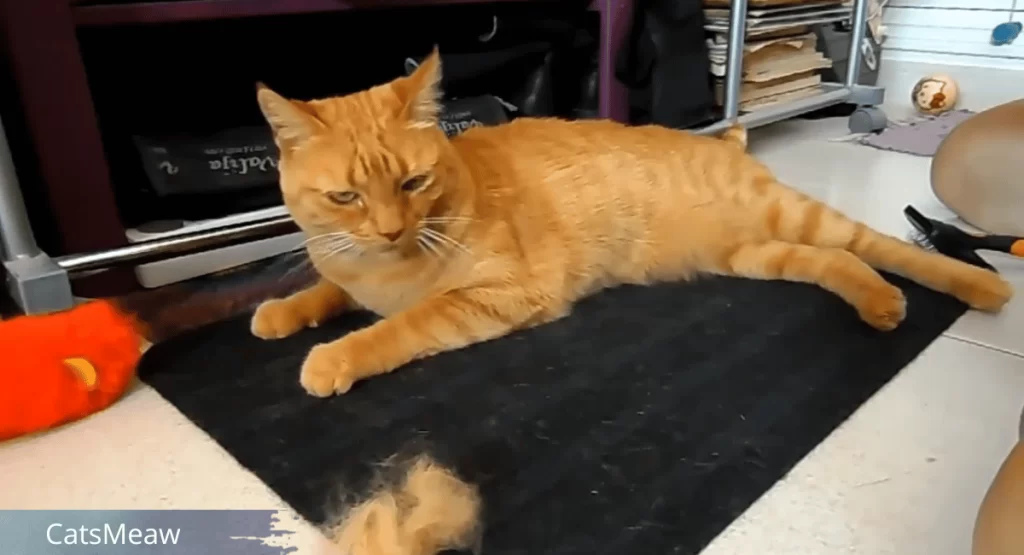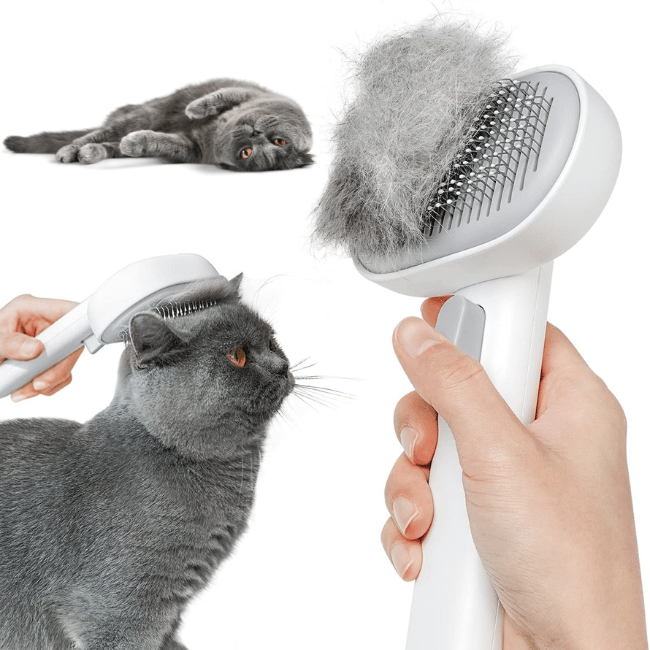Is your furry feline friend experiencing hair loss? Don’t panic just yet! In this comprehensive guide, we’ll walk you through everything you need to know about managing hair loss in cats. From the causes and symptoms to treatment options and preventive measures, we’ve got you covered.

Table of Contents
Understanding Cat Alopecia
Hair loss, also known as alopecia, can be caused by various factors such as allergies, infections, hormonal imbalances, and parasites. Identifying the root cause is essential in determining the most effective treatment plan for your cat.
Our feline friends are susceptible to hair loss, just like humans. However, it’s important to understand that cats have different hair growth cycles compared to humans. While humans typically shed hair all year round, cats experience seasonal shedding. Understanding this difference will help you differentiate between normal shedding and abnormal hair loss in cats.
Additionally, it’s crucial to be aware that certain cat breeds are more prone to hair loss than others. Breeds such as the Sphynx, Devon Rex, and Cornish Rex naturally have less hair, while others, like the Maine Coon and Persian, have long, luxurious coats that require regular grooming to prevent matting and hair loss.
Causes of hair loss in cats
Hair loss in cats can be caused by a multitude of factors, both internal and external. Allergies, for example, can lead to excessive scratching and hair loss. Cats can develop allergies to certain foods, environmental factors such as pollen or dust mites, or even flea bites. Fleas, in particular, can cause severe itching and hair loss if left untreated.
Our pick: The Best Cat Grooming Supplies
Infections, such as fungal or bacterial infections, can also result in hair loss in cats. These infections often occur in areas where the skin is compromised, such as wounds or areas of excessive scratching. Parasites, including mites and ticks, can also cause hair loss in cats. These tiny creatures can irritate the skin and lead to excessive scratching, resulting in hair loss over time.
Hormonal imbalances, such as an overactive or underactive thyroid gland, can also contribute to hair loss in cats. Additionally, certain medications or treatments, such as chemotherapy, may cause temporary or permanent hair loss. Identifying the underlying cause of alopecia is essential in determining the most appropriate treatment plan for your furry friend.
Types of alopecia in cats
Alopecia in cats can present in different forms, depending on the underlying cause. The three main types of alopecia in cats are:
1- Symmetrical alopecia: This type of hair loss in cats occurs symmetrically on both sides of the body. It often affects the abdomen, back, and sides of the cat. Symmetrical alopecia is commonly associated with allergies or hormonal imbalances.
2- Focal alopecia: Focal alopecia refers to hair loss in specific localized areas. It can be caused by infections, parasites, or trauma. For example, if your cat constantly licks or chews on a particular area, it may result in focal alopecia in that specific spot.
3- Diffuse alopecia: Diffuse alopecia refers to hair loss that occurs all over the body. This type of alopecia is commonly associated with underlying systemic diseases, such as kidney or liver disease. If your cat is experiencing diffuse hair loss, it’s crucial to consult a veterinarian for a proper diagnosis and treatment plan.
Symptoms and signs of feline alopecia
Recognizing the symptoms and signs of feline alopecia is crucial in addressing the issue promptly. Some common signs of hair loss in cats include:
1- Bald patches or thinning hair: Observe your cat’s coat regularly for any areas where the hair is noticeably thinning or completely absent. These bald patches can occur anywhere on the body.
2- Excessive scratching or licking: If your cat is constantly scratching or licking certain areas, it may indicate discomfort or irritation. This excessive grooming can lead to hair loss in those specific areas.
3- Redness or inflammation: Check your cat’s skin for any signs of redness or inflammation. These symptoms may indicate an underlying infection or allergy.
4- Skin lesions or sores: Hair loss in cats can sometimes be accompanied by the development of skin lesions or sores. These lesions can be itchy or painful for your cat.
5- Changes in behavior or mood: If your cat is experiencing discomfort due to hair loss, they may exhibit changes in behavior or mood. They might become more irritable or withdrawn.
If you notice any of these symptoms in your cat, it’s essential to consult a veterinarian for a proper diagnosis and treatment plan. Early intervention can help prevent further hair loss and alleviate any discomfort your cat may be experiencing.
Related: Best Interactive Toys for Indoor Cats
Diagnosing hair loss in cats
Diagnosing the underlying cause of hair loss in cats requires a thorough examination and potentially additional tests. A veterinarian will typically start by conducting a physical examination of your cat’s skin and coat. They may ask you questions about your cat’s medical history, diet, and living environment.

In some cases, additional tests may be necessary to determine the exact cause of alopecia. These tests may include bloodwork, skin scrapings, or allergy testing. Bloodwork can help identify any underlying hormonal imbalances or common diseases such as systemic diseases. Skin scrapings can detect the presence of parasites, while allergy testing can pinpoint specific allergens that may be causing the hair loss in cats.
Once a diagnosis is made, your veterinarian will work with you to develop a treatment plan tailored to your cat’s specific needs. Treatment options can vary depending on the underlying cause of alopecia and may include medications, dietary changes, or lifestyle adjustments.
Treating feline alopecia
The treatment of feline alopecia largely depends on the underlying cause. Here are some common treatment options:
1- Allergy management: If allergies are the root cause of your cat’s hair loss, your veterinarian may recommend allergy testing to identify the specific allergens. Depending on the results, they may suggest dietary changes, environmental modifications, or prescribe medication to manage the allergies.
2- Parasite control: If parasites, such as fleas or mites, are causing the hair loss, your veterinarian will prescribe appropriate medications to eliminate the infestation. They may also recommend regular preventive treatments to avoid future infestations.
3- Hormonal therapy: In cases where hormonal imbalances are the cause of alopecia, hormonal therapy may be necessary. Your veterinarian will determine the appropriate medication or treatment plan to restore hormonal balance.
4-Topical treatments: Depending on the underlying cause, your veterinarian may recommend topical treatments, such as medicated shampoos or ointments, to soothe the skin and promote hair regrowth.
5- Dietary changes: In some cases, dietary changes may be necessary to address underlying nutritional deficiencies or food allergies. Your veterinarian may suggest specific diets or supplements & vitamins to support your cat’s overall health and promote a healthy coat.
It’s important to follow your veterinarian’s instructions closely and be patient during the treatment process. Hair regrowth may take time, and it’s crucial to address the underlying cause to prevent recurrence of alopecia.
Managing hair loss in cats at home
In addition to veterinary treatment, there are several steps you can take at home to manage and support your cat’s hair health:
1- Regular grooming: Regularly brushing your cat’s coat using a cat grooming brush can help distribute natural oils and prevent matting. It also allows you to monitor your cat’s skin and coat for any changes or signs of hair loss.
2- Stress reduction: Stress can contribute to hair loss in cats. Creating a calm and enriched environment for your cat can help reduce stress levels. Provide plenty of hiding spots, vertical spaces, and interactive toys to keep your cat mentally stimulated.
3- Balanced diet: Ensure your cat’s diet is nutritionally balanced and appropriate for their age and health condition. A diet rich in essential fatty acids, vitamins, and minerals can promote a healthy coat.
4- Environmental cleanliness: Regularly clean your cat’s living environment to minimize exposure to potential allergens or irritants. Vacuum and dust regularly to reduce the presence of allergens such as pollen or dust mites.
5- Regular veterinary check-ups: Schedule regular check-ups with your veterinarian to monitor your cat’s overall health and address any concerns promptly. Early intervention can help prevent hair loss and promote optimal feline well-being.
Remember, each cat is unique, and what works for one may not work for another. It’s important to consult with your veterinarian to determine the most suitable management plan for your cat’s specific needs.
Preventing hair loss in cats
While not all cases of hair loss can be prevented, there are measures you can take to minimize the risk of hair loss in cats in your cat:
1- Regular flea control: Implement a regular flea control program to prevent infestations. Consult your veterinarian for the most appropriate flea prevention products for your cat.
2- Allergy management: If your cat has known allergies, work with your veterinarian to develop a management plan. This may include identifying and avoiding specific allergens or implementing dietary changes.
3- Stress management: Minimize stress in your cat’s life by providing a calm and enriched environment. This includes providing areas for hiding, vertical spaces for climbing, and interactive toys for mental stimulation.
4- Regular grooming: Regularly brush your cat’s coat to prevent matting and distribute natural oils. This can also help you detect any changes or signs of hair loss early on.
5- Balanced diet: Feed your cat a nutritionally balanced diet that supports overall health and promotes a healthy coat. Consult your veterinarian for dietary recommendations specific to your cat’s needs.
6- Environmental cleanliness: Regularly clean your cat’s living environment to reduce exposure to potential allergens or irritants. This includes cleaning litter boxes, vacuuming, and dusting regularly.
Related: 7 Most Dangerous Foods for Cats
By implementing these preventive measures, you can help reduce the risk of hair loss in cats in your cat and promote overall well-being. However, it’s important to remember that some cases of alopecia may be unavoidable, and prompt veterinary care is crucial for accurate diagnosis and treatment.
When to seek veterinary help for feline alopecia
If you notice any signs of hair loss or changes in your cat’s coat, it’s important to seek veterinary help. A veterinarian will be able to accurately diagnose the cause of hair loss and recommend appropriate treatment options. Prompt veterinary care can help prevent further hair loss and address any underlying health issues your cat may be experiencing.
Remember, early intervention is key in managing feline alopecia effectively. Your veterinarian is your best resource for guidance and support, so don’t hesitate to reach out if you have any concerns about your cat’s hair health. Together, you can restore your cat’s majestic mane and strengthen the bond you share.
Caring for your cat’s hair health
Understanding the ins and outs of feline alopecia will not only help you address the issue promptly but also strengthen the bond you have with your beloved pet. By familiarizing yourself with the causes, symptoms, and treatment options for hair loss in cats, you can provide the best possible care for your furry friend. Remember to consult with your veterinarian for a proper diagnosis and treatment plan tailored to your cat’s specific needs. With patience, dedication, and veterinary guidance, you can manage your cat’s hair loss and restore their majestic mane in no time!

